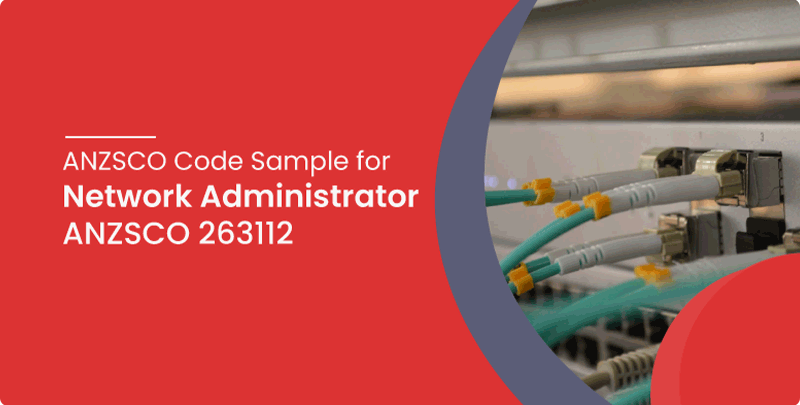Get Free Consultation
ANZSCO Code
ANZSCO 263112 Network Administrator
Network Administrator installs and maintains hardware and software, documents diagnosis and resolution of faults, manages user passwords, security and inventory documentation, ensures the efficient performance of servers, printers and personal computers, and attends to other operational tasks. May also perform tasks such as help desk support and user training.
Skill Level
Level 1 or Equivalent
Specializations
LAN Administrator
Skills Assessment Authority
ACS (Australian Computer Society)
Alternative Titles
Network Specialist
Network Support

On the Occupation Lists:
- Combined Skilled Occupations List (STSOL MLTSSL)
- Short-Term Skilled Occupation List (STSOL)
- RSMS Occupations List (RSMSL)
Not on the Occupation Lists:
- Labour Market Testing Required for 457 List (LMTL)
- Medium Long Term Strategic Skills List (MLTSSL)
Visa Provision
As the occupation features on the Short-term Skilled Occupation List (STSOL), it is possible to apply for a Skilled Nominated 190 visa or a Skilled Regional Nominated 489 visa. If you are employed in this occupation and you wish to pursue a GSM visa, you will be required to apply for state nomination in order to move to Australia.
Note: *Please note that while the occupation is on the STSOL it remains a possibility that no states currently have a demand for people in that profession. The online assessment only lists occupations which are currently in demand by a state or territory in Australia, so if the occupation does not appear on the online assessment you should consider seeking an employer sponsor in Australia.
Unit Group: 2631 Computer Network Professionals
The job of a network administrator in Australia is to research, analyze and recommend strategies for network architecture and development, implement, manage, maintain and configure network hardware and software, and monitor and optimize performance, and troubleshoot and provide user support.
Skill Level
Most occupations in this unit group have a level of skill commensurate with a bachelor degree or higher qualification. At least five years of relevant experience and/or relevant vendor certification may substitute for the formal qualification. In some instances relevant experience and/or on-the-job training may be required in addition to the formal qualification (ANZSCO Skill Level 1).
English Requirement
- IELTS result with a minimum score of 6 (L, R, W), 7 in speaking and 7 overall;
- OET result with a minimum grade B in all sections;
- TOEFL iBT with a minimum score (L:12 R:13 W:21 S:23 overall L93);
- PTE Academic with a min score of 50 (L, R, W), 65 in speaking and 65 overall
Exceptions
- Australian Graduate exceptions apply in some states/territories
- Priority Skilled Lists may apply a specific requirement in some states
- Countries exempt from submitting IELTS or OET include the UK; Canada; New Zealand; US; and Ireland Where mandatory licensing or registration is required you must demonstrate a level of English either sufficient to meet licensing / registration or a minimum IELTS, or equivalent, whichever is higher.
Occupations in this Group
- 263111 Computer Network and Systems Engineer
- 263112 Network Administrator
- 263113 Network Analyst
Tasks to Perform
- Analyzing, developing, interpreting and evaluating complex system design and architecture specifications, data models and diagrams in the development, configuration and integration of computer systems
- Researching, analyzing, evaluating and monitoring network infrastructure to ensure networks are configured to operate at optimal performance
- Assessing and recommending improvements to network operations and integrated hardware, software, communications and operating systems
- Providing specialist skills in supporting and troubleshooting network problems and emergencies
- Installing, configuring, testing, maintaining and administering new and upgraded networks, software database applications, servers and workstations
- Providing network programming in support of specific business needs and requirements
- Preparing and maintaining procedures and documentation for network inventory, and recording diagnosis and resolution of network faults, enhancements and modifications to networks, and maintenance instructions
- Monitoring network traffic, and activity, capacity and usage to ensure continued integrity and optimal network performance
Closely Related Core ICT Units
- Computer Communication
- Computer Network Design
- Computer Network management
- Computer Network programming
- Computer Network protocols
- Data communications – (WAN, LAN)
- Mobile technologies
- Operating systems – (Unix, Linux, Xenix, Network OS)
- Wireless technologies – (Wireless Communication, Microwave Communication)
Brief Description
The major roles and responsibilities of network analyst includes installs and maintains hardware and software, documents diagnosis and resolution of faults, manages user passwords, security and inventory documentation, ensures the efficient performance of servers, printers and personal computers, and attends to other operational tasks. It also includes the different network design and network management with network programming. Network Administrator in mobile technologies is also implemented. It works under all the operating system like UNIX, Linux, and Network OS. Wireless technologies that allows us to communicate without using cables or wires. With people and other entities can communicate over very long distances. So for the long distance also network administrator helps to formulate the plan and policies.
Additional Closely Related Core ICT Units
- Assembler Languages – (Assembler Programming)
- Client / Server related hardware and software
- Computer Architecture
- Computer Logic Design
- Computer organization
- Digital and signal processing
- Digital circuits – (VLSI Design, Integrated Circuit Design)
- Digital technology
- Introduction to ICT – (Introduction to Computer Science, Computer Theory, Introduction to Business Computing, Computer Science I)
- Microprocessors
- Microwave technology
- Network Component technologies
- Network security
- Optical communication technology
- Peripherals and Interfacing
- Project Management
- Satellite communications


